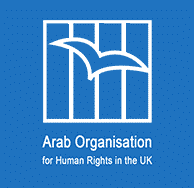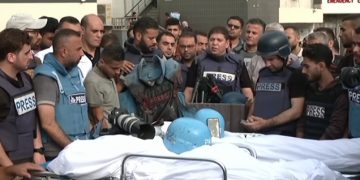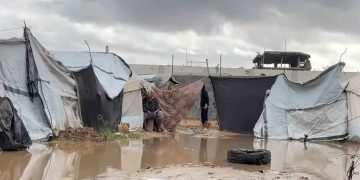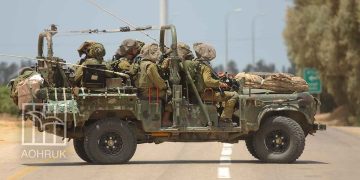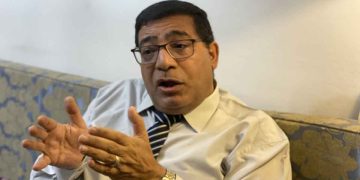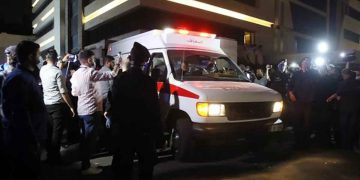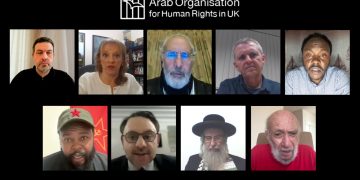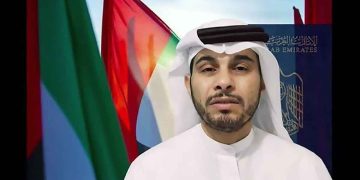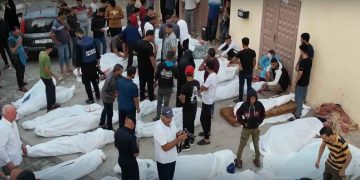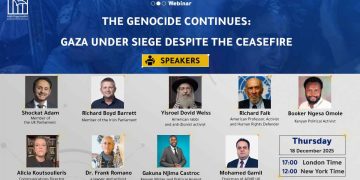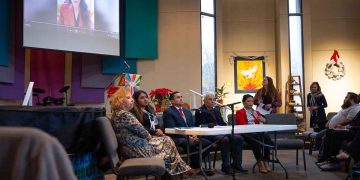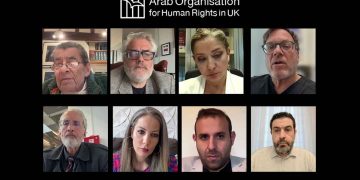Arab Organisation for Human Rights in the UK (AOHR UK) held a webinar titled “The Gaza Humanitarian Foundation’s Role in the Crime of Genocide” on Thursday, 7 August 2025. The webinar examined the role of the so-called Gaza Humanitarian Foundation (GHF) in facilitating and accelerating Israel’s ongoing genocide in the Gaza Strip. Speakers addressed how the GHF has operated not as a lifeline for civilians, but as a mechanism that multiplies death and destruction, contributing to starvation, forced displacement, and the continuation of mass violence under the guise of humanitarian aid. The discussion highlighted the use of food as a weapon of war, the targeting of aid mechanisms, and the deliberate creation of conditions designed to ethnically cleanse Gaza’s remaining population.
The webinar featured a panel of distinguished speakers: Francesca Albanese, United Nations Special Rapporteur on the situation of human rights in the Palestinian territories occupied since 1967; Anthony Aguilar, former contractor with the Gaza Humanitarian Foundation and an eyewitness to its operations; Chris Smalls, American activist recently returned from the Handala aid ship; Dr. James Smith, British doctor who worked at Al-Aqsa Martyrs Hospital in Gaza; Professor Stephen Zunes, Professor of International Security and Foreign Policy at the University of San Francisco; Dr. Junaid Sultan, doctor recently returned from Gaza; Tanya Haj-Hassan, doctor recently returned from Gaza; and Mohammed Jamil, Director of AOHR UK. Each offered detailed testimony and analysis exposing the GHF’s complicity in the genocide and the urgent need for international accountability.
Francesca Albanese, United Nations Special Rapporteur on the situation of human rights in the Palestinian territories occupied since 1967, opened her remarks with a clear condemnation of the Gaza Humanitarian Foundation (GHF), stressing that it should never have been created or operational in the first place. She emphasised that in a situation of emergency such as Gaza’s, there were already a number of legitimate actors with proven capacity to deliver aid and relief — including multilateral entities connected to the United Nations and reputable non-governmental organisations — which had been dismantled or incapacitated. In her view, replacing these legitimate actors with an ad-hoc body like GHF was unjustifiable and fundamentally contrary to the principles that inspire humanitarian action: humanity, independence, neutrality, and the obligation to cause no harm. She underlined that Israel, with the support of the United States and others, had deliberately incapacitated UNRWA and substituted it with this new structure.
Albanese stated that her concerns had existed since the inception of the GHF but had been reinforced after examining its operations over more than three months, during which it claimed to distribute food but in reality had presided over the killing of more than 1,200 people. Without even accounting for inside testimonies like that of Anthony Aguilar, she noted that from an outside perspective alone, the GHF had already accumulated the track record of a “death trap” rather than a humanitarian organisation. She went further, describing it as operating more like a “joint criminal endeavour” than an aid body. For her, the evidence showed that this was not an entity grounded in humanitarian values, but one contributing directly to harm and loss of life.
She concluded by stressing that no role should be contemplated for the GHF in any genuine humanitarian framework. Albanese criticised member states that continued to engage with Israel on food distribution, given that Israel itself stood accused of using starvation as a weapon of war — a crime under international law that forbids the use of starvation even against enemies. In Gaza, she warned, starvation was not merely incidental but was being employed as a genocidal tool against the entire population. This, she argued, was yet another instrument in advancing the genocide of Gaza, and therefore she believed that judicial proceedings should be initiated against the GHF and its executives as soon as possible.
Anthony Aguilar, a former security contractor with UG Solutions working inside Gaza’s so-called “aid distribution” sites for the Gaza Humanitarian Foundation (GHF), began by identifying himself as an eyewitness to what he described as a deeply flawed and harmful system. Aguilar stated that he spent a contracted period working in all four GHF distribution sites — three located in Rafah and one in central Gaza near the Netzarim Corridor. His role gave him direct, on-the-ground access to observe the daily functioning of the operation, which he said fundamentally failed to meet the needs of the besieged population. He made it clear that the GHF’s public image of delivering life-saving aid was completely at odds with the reality he witnessed.
From his observations, Aguilar explained that the GHF’s supply system was incapable of feeding Gaza’s population. Entire sections of the Strip went without any deliveries for weeks at a time. The aid consisted only of dry goods — rice, lentils, flour — with no water provided at all. He noted that the GHF publicly boasted of delivering 109 million meals over 73 days, but when calculated against Gaza’s 2.1 million people, the numbers told a different story. At three meals per day, the food would last just 17 days; at one meal per day, only 22 days. He stressed that this reality bore no resemblance to sustained humanitarian relief.
Aguilar further revealed that the caloric value of each so-called “meal” was grossly insufficient. Post-cooking, the food contained only 220 kilocalories — far below what is needed to meet even minimal daily survival requirements. He emphasised that this was not aid that could prevent starvation or malnutrition, but rather token rations that ensured the population remained in a state of deprivation. In his view, the GHF’s operations were not designed to relieve the humanitarian crisis, but to perpetuate it.
Equally disturbing, Aguilar said, was the fact that all four distribution sites were constructed by the Coordination of Government Activities in the Territories (COGAT) and the Israeli Occupation Forces (IOF) and placed deliberately within active combat zones during ongoing Israeli offensive operations. This meant that unarmed civilians — including women, children, and families — were forced to gather in areas where they were exposed to live fire and other forms of military aggression while waiting for food. He recalled that both GHF and IOF officials admitted to firing “warning shots” over people’s heads, at their feet, or “towards the sea” — a coastline crowded daily with hundreds of thousands of displaced civilians trying to survive. Aguilar dismissed the term “warning shot” outright, stating bluntly: “A warning shot is a bullet.”
Aguilar described other crowd-control tactics used at these sites as war crimes under international humanitarian law. Tear gas and stun grenades were deployed against unarmed people standing in food lines, further endangering their safety and health. He underscored that these were not combatants but innocent civilians seeking survival. Such actions, he said, could not be justified under any humanitarian mandate and revealed the true nature of the GHF’s operations.
Aguilar declared that the GHF was “not a humanitarian organisation” but rather “a mechanism that is actively leading to further starvation and famine.” He warned that the world must wake up to the reality that what was presented as aid was in fact a weaponised system controlled by the IOF to tighten the siege and deepen the suffering of Gaza’s population. His testimony called for urgent international recognition of the GHF’s role in perpetuating the humanitarian catastrophe and for accountability for those responsible.
Anthony Aguilar confirmed that Israeli authorities were directly involved in the Gaza Humanitarian Foundation’s operations, with COGAT giving explicit orders on every aspect of aid delivery and distribution. He explained that GHF had no independent planning authority, as all instructions came through COGAT liaison officers from the IDF Southern Command stationed in the control centre alongside GHF personnel. They dictated when, where, and how much aid would be delivered, and could halt or cancel distributions at any moment — often after announcements had already been made to the public. This resulted in thousands of desperate Palestinians walking long distances to promised sites only to find no aid, creating panic and frustration. Aguilar stressed that such cancellations were often justified by citing combat operations, which in his view only highlighted the recklessness of building humanitarian distribution points in active conflict zones. He concluded that GHF served merely as a mechanism for the IDF and COGAT to deliver aid on their terms, under the façade of humanitarian work.
When asked when he began to doubt the humanitarian nature of the mission, Aguilar said that at first he believed in GHF’s stated goal of delivering large-scale food aid into Gaza. However, he soon realised the mechanism was never designed to replace or match the United Nations’ capacity. Even at its maximum, GHF could not come close to the scale of UNRWA or the World Food Programme — and in fact, even the much-disputed 5% of UN aid allegedly reaching civilians was still 28% more than GHF’s maximum output. GHF provided only dried food goods, with no capacity for essential humanitarian needs like fuel, medical supplies, clothing, or education materials. Aguilar described the project as “a facade of humanitarian assistance” whose true function was to systematically prolong the starvation of Gaza’s population.
Tanya Haj-Hassan, a paediatric intensive care doctor who visited Gaza twice — first in March 2024 and again during February–March 2025 — described the scale of destruction to Gaza’s healthcare system, particularly for children. She explained that even during her first visit, shortly after the ICJ’s ruling on plausible genocide, conditions in Al-Aqsa Hospital were so horrific she could not imagine them worsening — yet they did. By her second visit, during a ceasefire period, she was able to assess damage to key facilities and found that Gaza City and northern Gaza no longer had functioning paediatric or neonatal intensive care units from before October 2023. Major hospitals such as Nasser Paediatric Hospital and Al-Tisi had been destroyed, with evidence of deliberate targeting — Hebrew graffiti on walls, gunshot holes in equipment, and cables cut. Facilities like Al-Durra and Kamal Adwan, both with paediatric intensive care units, were also destroyed, eliminating essential subspecialty care for conditions such as cystic fibrosis, blood cancers, and chronic paediatric illnesses.
She detailed the collapse of cancer care in Gaza, noting that the Turkish Friendship Hospital — the only specialised cancer hospital — was seized as a military base by Israeli forces, then completely demolished. Cancer services were repeatedly displaced, with long periods when chemotherapy was unavailable. Even after relocation to Nasser Hospital, equipment for safely preparing chemotherapy drugs was inadequate. Haj-Hassan stressed that beyond the immediate trauma injuries, Gaza’s children face a “slow death” from untreated chronic illnesses and emerging diseases. She warned of an alarming outbreak of acute flaccid paralysis in children — cases progressing to full paralysis, including breathing muscles, within 24 hours — without the necessary drugs, equipment, or rehabilitation services to treat them. Many of these children, if they survive, face death from complications or lifelong disability without hope of recovery.
Speaking from her experience in other war zones, Haj-Hassan said nothing compares to the deliberate targeting of Gaza’s besieged civilian population — especially its children, who form nearly half of the injured. She described leaving Gaza with her paediatric intensive care unit full of maimed children, most having lost their families, with injuries requiring rehabilitation that is simply impossible under current conditions. She read a message from a Gaza colleague whose daughter, a dental student, lost her leg in an airstrike that killed several family members. His plea was to help evacuate her and to tell the world that “childhood here is being exterminated for no crime,” that Gaza’s people “deserve life” and are “awaiting death at any moment,” clinging only to the hope that justice might come in their lifetime.
Mohamed Jamil, chairman of AOHR UK, stressed that the ongoing genocide in Gaza requires relentless work to break the global silence. He explained that AOHR UK recently appealed to a group of states to request a meeting of the UN General Assembly under the still-open 10th Emergency Special Session, convened pursuant to the Uniting for Peace resolution. This mechanism allows the General Assembly to act when the Security Council is paralysed by vetoes, as happened in past cases such as the 1956 attack on Egypt by Britain, France, and Israel, when decisive GA action forced an end to the aggression. He urged that, while recent meetings of the 10th Emergency Session have yielded resolutions, none have been enforced due to a lack of political will, particularly because of U.S. support for Israel and the complicity of Arab regimes. Jamil argued that superpowers like China and Russia could be engaged to help implement General Assembly resolutions, and proposed that a coalition of 100 states send a humanitarian convoy through Rafah—led by major powers—to challenge Israel’s blockade without requiring military intervention.
Jamil went on to commend Colonel Anthony for breaking his silence and exposing violations, killings, torture, and the manipulation of distribution centres run by the so-called Gaza Humanitarian Foundation (GHF). He revealed that AOHR UK team had submitted multiple legal applications: a detailed 70-page submission to the ICC naming six GHF officials for investigation over genocide, war crimes, and crimes against humanity; sanctions requests to the EU, UK, and other jurisdictions under Magnitsky-style laws; and national criminal cases in several countries. He disclosed for the first time that a senior GHF official with Armenian nationality—linked to the UAE—had been targeted in a legal complaint filed with the Armenian Prosecutor General, backed by political outreach to Armenian parliamentarians. Jamil vowed to pursue every possible avenue for justice, noting that he had contacted more than 100 European MPs, and urged anyone with legal means or evidence to come forward. He concluded that these crimes are unprecedented in their brutality and pledged not to abandon the fight for accountability, even in the face of threats and ongoing atrocities.
Chris Smalls, founder of the Amazon Labor Union and a volunteer on the Handala’s 37th mission to break Israel’s illegal siege, described in detail the events of the interception. Less than 60 miles from Gaza, in international waters where Israel has no jurisdiction, the Israeli Occupation Forces (IOF) boarded the vessel at night, cutting communications to hide their actions from the world. Smalls recounted being held captive on deck with hands raised as the ship was diverted to the port of Ashdod, a 12-hour journey away from Gaza. During his night shifts prior to interception, he observed heavy drone activity—at least 50 drones from various countries each night—used not for rescue but for surveillance and military operations. On the night of the attack, drones dropped smoke flares that reduced visibility while the IOF closed in, surrounding the boat in a coordinated military manoeuvre.
Upon boarding, the IOF acknowledged the crew’s hunger strike but brought food and a camera crew to stage propaganda, attempting to film detainees eating. Smalls emphasised that the soldiers belonged to Unit 13, which he described as a “killing machine” responsible for atrocities such as sniping children and unplugging incubators. To his shock, most appeared to be young adults in their early twenties—“average college kids” brainwashed into believing they were performing an honourable duty. As an American citizen, Smalls was acutely aware that U.S. taxpayers were funding the advanced weapons and technology being used to stop the delivery of humanitarian supplies—medical equipment, baby formula, baby food, and even stuffed animals—destined for Gaza.
Smalls explained that upon arrival at the port, crew members were taken off the ship by nationality, with Americans left until last. A camera crew awaited them, and the detainees responded with chants of “Free Palestine” and “Bella Ciao.” Unlike the heavily publicised images from the Madeline mission, there were few Israeli propaganda photos released from the Handala—something Smalls attributes to what happened next. He was violently assaulted by seven Israeli authorities, thrown to the ground, choked, and subjected to racist abuse, with officers telling him they were “the furthest thing from” his brothers. He was separated from the rest of the crew and held in a room where the abuse continued. Smalls stated that he was targeted because of the colour of his skin, describing the deep-seated hatred for both people of colour and Palestinians that he experienced during his five days in Israeli captivity as the most extreme racism and bigotry he had ever faced in his life.
In his contribution, Zenus began by outlining the historical precedent of the 1956 Suez War, explaining that the decisive factor in forcing Israel’s withdrawal was the direct pressure applied by U.S. President Dwight Eisenhower, despite Britain and France vetoing action at the UN. At that time, the United States used its economic leverage over close allies—France, which still owed substantial post–World War II loans, and Israel, which depended heavily on American fundraising through the Jewish National Fund. Eisenhower threatened to revoke the JNF’s tax-exempt status if Israel refused to withdraw, demonstrating that Washington has the capacity to compel Israeli policy shifts. He recalled that subsequent U.S. presidents, including Nixon, Carter, Reagan, George H.W. Bush, and Obama, had all used the threat of withholding military or financial aid to pressure Israel into withdrawals, ceasefires, or other concessions, underscoring that this is not a “tail wagging the dog” situation—the United States holds decisive leverage.
He contrasted that history with the present, arguing that famine in Gaza—engineered by Israel with direct U.S. support—has created a political shift in Washington. While other genocides involving starvation, such as those in Sudan, Burma against the Rohingya, Bangladesh in 1971, Guatemala in the 1980s, and East Timor during Indonesian occupation, were supported or tolerated by the U.S., they remained largely hidden from public awareness at the time. In Gaza, however, the atrocities are visible to the world in real time, making U.S. complicity even more indefensible. The so-called Gaza Humanitarian Foundation (GHF), which Zenus described as an instrument of propaganda and obstruction, has intensified public outrage. For the first time, a majority of Democrats in Congress have voted to restrict some military aid to Israel, and a bill has been introduced to end U.S. funding for the GHF. This shift, while possibly motivated as much by political calculation as moral outrage, marks an unprecedented breach in the bipartisan shield protecting Israel.
Zenus warned, however, that much of the Democratic criticism is framed as opposition to Prime Minister Netanyahu personally, sidestepping the reality that his policies are supported by a majority of Israelis. Nonetheless, he observed that Democratic leaders now appear more fearful of backlash from their constituents than of the powerful pro-Israel lobby AIPAC—a reversal from decades past. The growing visibility of mass starvation has emboldened mainstream liberal, progressive, and peace organisations that previously avoided the Israel-Palestine issue, prompting them to speak out. Even within the Jewish community, over a thousand rabbis—mostly American—have signed an open letter condemning “the mass killing of civilians and the use of starvation as a weapon of war,” calling for extensive humanitarian aid to Gaza and an end to settler violence in the West Bank. For Zenus, these developments signal that the political landscape in the U.S. is shifting in ways not seen before, and that the humanitarian catastrophe in Gaza is forcing conversations long suppressed in the American mainstream.
Dr. James Smith described the Gaza Humanitarian Foundation (GHF) as “no less than a death multiplier in Gaza,” highlighting its role in intensifying the scale of violence rather than alleviating suffering. Citing a recent Médecins Sans Frontières (MSF) report, he said the GHF functions as “a process of orchestrated killing,” with approximately a quarter of Palestinians killed since its introduction having died in or around GHF-managed locations. He noted that the rise in injuries between May and June 2025 was the steepest since the first three months of the genocide, surpassing levels seen since December 2023. Senior ER doctors in Nusirat, Deir al-Balah, and Khan Yunis described to him an escalation of extreme violence, with emergency rooms at Nasser and Al-Aqsa hospitals overwhelmed, patients treated on the floor, and healthcare workers operating under horrific conditions. One colleague reported inserting 50 chest tubes in a single day—more than many UK emergency physicians perform in an entire career—underscoring the unprecedented scale of suffering.
He warned that the genocide has now entered what he termed “the stage of the humanitarian alibi,” where the language of humanitarianism is co-opted to mask the continuation of mass atrocities. Israel, he said, has appropriated the vocabulary of aid work as a “paper-thin” pretext to deflect condemnation, allowing it to prolong and intensify its military campaign under the guise of charity. This supposed humanitarian mechanism, focused only on food while ignoring water, shelter, and medicine, operates alongside explicit statements by Israeli leaders of plans to impose total military occupation over Gaza and to ethnically cleanse the population southwards into a so-called “humanitarian city.” Dr. Smith stressed that this is not genuine relief but a calculated strategy to continue the genocide “by other means.”
Dr. Smith emphasised that the GHF’s own admissions, along with recent IPC analyses, confirm that its food aid strategy is grossly inadequate. The number of meals and their caloric content fall far short of meeting survival needs, with IPC findings showing that the GHF’s distribution plan “would lead to mass starvation” even under ideal, violence-free conditions. In reality, the GHF is functioning exactly as intended—to multiply damage and death, and to create coercive conditions forcing Palestinians to choose between remaining in their homes under siege or fleeing south in search of minimal sustenance. This deliberate creation of displacement through deprivation, he concluded, constitutes a war crime under international law.
Dr. Junaid Sultan described the genocide in Gaza as “one of the few very unique genocides” in modern history, made distinct by the fact that it is unfolding in full public view, “a live telecast… second by second,” directly on people’s phones. Unlike other genocides, he said, this one is occurring inside what he termed a “concentration camp,” where the entire population is wholly dependent on the oppressors for survival. He stressed that no other authority, including the World Health Organization or any UN body, appears capable of improving the situation or altering its course. This complete dependence, he noted, makes the genocide fundamentally different from others, as the population has no alternative lifeline and remains trapped under the total control of those committing the atrocities.
Turning to the focus of the webinar, Dr. Sultan identified starvation as a deliberate, man-made weapon in this stage of the genocide. He described it as the final, devastating tool in a broader strategy that has already employed mass displacement, the destruction of medical institutions, relentless bombing, gunfire, and killings, alongside the loss of sanitation, water, and other essentials. These actions, he explained, have created an environment in which starvation can now multiply the harm “by 10 times.” Gaza’s population, he said, is immunocompromised, psychologically exhausted, and pushed to “their tethering point,” making them acutely vulnerable. At this stage, he warned, starvation could cause greater and more widespread loss of life than bombs and bullets, especially as medical facilities—already overwhelmed—will have no capacity to cope with the scale of need.
Dr. Sultan cautioned that the situation is approaching an irreversible tipping point, where the damage will be “extensive, huge, and catastrophic,” potentially killing thousands. He stressed the urgent need for decisive international action, invoking Article 42 and calling for the deployment of a peacekeeping force to open a humanitarian corridor. This, he said, is essential to deliver aid immediately and avert mass death. Without such intervention, the combination of siege, deprivation, and medical collapse will push Gaza into a phase of the genocide from which recovery will be impossible.
